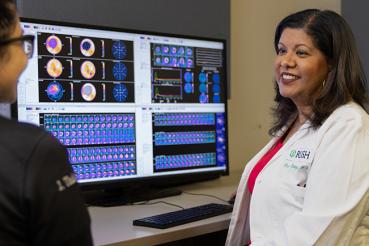Feeling more tired than usual? Experiencing pelvic pain? It could be a problem with your arteries and veins.
Vascular issues affect the arteries and veins that carry blood between your heart and the rest of your body.
You can think of your vascular system like your body’s highways or roads and your blood as traffic. When the roads are in bad shape or get too narrow, traffic can get backed up or stop. That can cause big problems.
The symptoms women face can differ from what men experience with the same vascular issues. But symptoms aren’t the only things that can differ between men and women.
“Both can be diagnosed with the same wide range of vascular problems,” says Michele Richard, MD, a vascular surgeon at RUSH. “But there are often differences in diagnosis, management and outcomes between men and women.”
What should women watch out for?
There are many types of vascular conditions. They include aortic aneurysm, carotid stenosis and stroke, and arterial blockages in the legs known as peripheral arterial disease, or PAD.
The usual signs can vary between conditions, but they may include pain or numbness in the legs and feet, abdominal or back pain, blurred vision, confusion, and numbness or weakness on one side of the body. People of any gender can have these symptoms.
But women may experience other symptoms that are unusual. Some vascular issues can, for example, cause chronic pelvic pain.
“Pelvic congestion syndrome is more commonly seen in women and occurs when ovarian veins develop dysfunction,” Richard says. “More blood becomes congested in the pelvis, which can result in debilitating pelvic pain.”
“Chronic pelvic pain in women can sometimes be dismissed or misdiagnosed, resulting in women not receiving appropriate treatment and continuing to live with debilitating pain,” Richard says. “That’s even more unfortunate because the treatment is usually minimally invasive — a small procedure that gives large relief.”
Stroke, which is often caused by carotid artery disease, can also appear differently in women.
"Women are more likely to have nontraditional stroke signs and symptoms, such as fatigue, generalized weakness, change in mental status and loss of consciousness,” Richard says. “This means women are more likely to delay seeking medical treatment for stroke symptoms."
Different treatments, more complications
Even when vascular issues are properly diagnosed in women, their treatment can differ from men, and women face more complications.
“Women’s arteries are typically smaller than the male equivalent,” Richard says. “This can create operative challenges and increase the risk of complications. For example, women have a higher risk of stroke, heart attack and other issues following treatment for carotid disease.”
Physicians consider these risks when they choose care plans to manage women’s vascular problems. This is especially true when it comes to surgery to remove plaque in the arteries or placing a stent, a small tube that opens narrowed arteries.
“With aneurysmal disease, women are less likely to undergo endovascular stent graft due to smaller-sized arteries and other anatomical differences,” Richard says. “They are more likely to present with unexpected emergency ruptures. So careful patient selection is especially important.”
The causes, and what you can do about them
There are some risks that can contribute to vascular problems in women that men generally don’t face.
“Some risk factors are gender-dependent, such as having a history of pregnancy or multiple pregnancies," Richard says. “This can increase the risk of certain diseases, such as pelvic congestion syndrome for example.”
For these gender-dependent risks, there aren’t many steps you can take to reduce them.
“There are no major modifiable risk factors for patients to change,” Richard says. “Instead, recognition is the most important, since many of the symptoms can be dismissed or ignored.”
But other risks for vascular issues apply to both men and women. These include smoking, hypertension and a family history of vascular problems.
Among the risks for all common vascular diseases, smoking is one of the worst. The good news is that it’s a risk that can be managed.
"Smoking is one of the most common causes of aortic aneurysm, peripheral arterial disease and stroke,” Richard says. “So aside from the usual healthy habits encouraged by primary care, like maintaining good blood pressure and cholesterol, quitting smoking is the biggest way to reduce risk that you can modify for both men and women.”
If you are having symptoms of vascular problems or are at risk, it’s important to tell your physician about all your concerns and ask for a full diagnosis.
What testing do you need?
Testing for vascular diseases isn’t very different for men and women. But women are often misdiagnosed or don't realize they’re having symptoms of vascular issues. Screenings can help you find any issues before they cause serious problems.
Richard notes that the type of testing you may need depends on your risks and whether you are having symptoms. Carotid ultrasound screening, for example, is recommended for patients at risk of stroke, such as those who have a history of smoking, high blood pressure or high cholesterol.
“Aortic aneurysm screening is also recommended in patients over the age of 65 with a history of smoking or family history of aneurysm,” Richard says.
Patients who are having symptoms of peripheral artery disease, including leg pain, may need diagnostic imaging, too.
If you are at risk for or having symptoms of vascular issues, RUSH offers heart and vascular screenings for an out-of-pocket cost starting at $49. You can call (312) 942-5741 to get started or learn more about possible treatments for vascular problems on our Vascular Surgery Services page.




